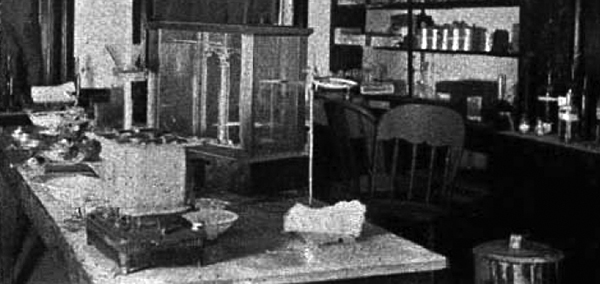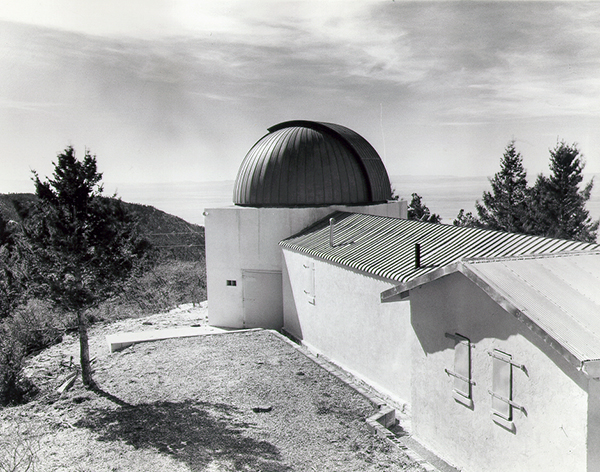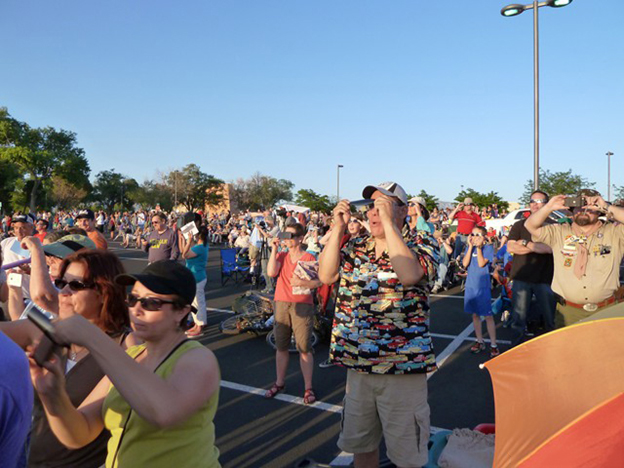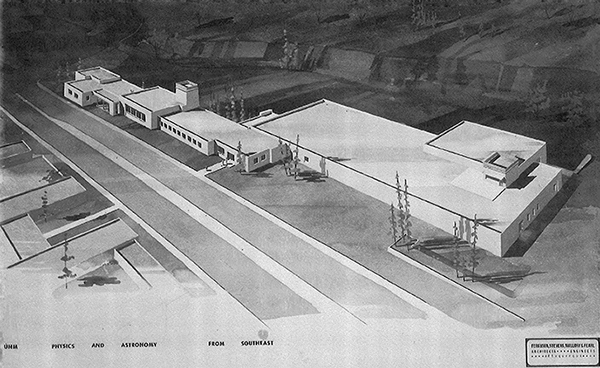UNM Department of Physics and Astronomy History
A Circuitous Route from Hodgin Hall to PAÍS
By John R. Green, Daniel Finley, and Bernd Bassalleck
A Condensed, Largely Facilities-Based History of the Department
For the comprehensive version, see the expanded history of the Department (.pdf)

Physics Lab 1898

Physics, Astronomy, and Interdisciplinary Science Building, 2020
From Beginning to WWII
The Beginning: 1892
From the very beginning, the school that became the University of New Mexico had the goal of providing its students with worthwhile training in physics.
The catalog of 1892 states:
A well-fitted laboratory will be arranged for the classes in Physics and Chemistry where students will be required to do practical work.
The First Labs: 1893
The next year, the catalog of 1893 has the following statement under "Physical and Chemical Laboratories":
Both of these laboratories will be fitted up this coming year, and the students will be given the opportunity of doing practical work in both Physics and Chemistry. It is now expected that over $1000 will be expended for apparatus this coming year, and the latest and best appliances will be added from time to time as funds are provided.
During these early years, it was possible to obtain the BS degree by having a concentration of mathematics and chemistry and with physics being taken in the senior year.
The work done in Physics has been of an elementary nature, consisting of recitations and experiments. Most of the experiments were shown from the desk, as the amount of apparatus on hand at present will not permit laboratory work in this branch. No one having applied for advanced work, there have been no advanced classes this year. About $200 worth of physical apparatus has been added this year. -- UNM Yearbook Mirage, 1898
By 1900, freshmen could take General Physics, including laboratory work, and then go on to courses in Electricity and Magnetism, Heat and Light, Mathematical Electricity and Magnetism, Analytical Mechanics, and Advanced Laboratory.
Hodgin Hall: 1892-1900
Until 1900 the laboratories were held in the basement of Hodgin Hall, which at the time was the only building on campus.
In 1908-09 physics was in the College of Letters and Science, which offered "courses leading to the degree of AB"; but in 1909-10, that college became the College of Letters and Arts. Physics consequently became part of the School of Science within the College of Science and Engineering, which at that time offered the degrees of BA, MA, or EE, CE, or ME. The offerings of the physics department increased from seven courses to 18, including two entitled "thesis work."
In 1916-17 the physics department was part of the College of Arts, Philosophy and Science. By 1918, students could obtain a major or a minor in physics with a degree of BA or BS. The department offered nineteen courses, including nine for advanced undergraduate or graduate students. In 1919 the physics department was part of the College of Arts and Sciences and was planning on equipping laboratories for advanced work in heat, light, and electricity and magnetism "as funds become available."
Lecture Hall: 1927

Science and Lecture Hall, 1928-1984
In 1927 the new Lecture Hall was under construction. This proved to be an excellent facility both for its size (about 250 students) and for its remarkable acoustics. There were two small rooms on either side of the front of the lecture hall in which equipment could be stored and brought out on practically an instant's notice for use in the hall.

Science and Lecture Hall, interior
Members of the physics department have always believed in the importance of lecture demonstrations, particularly in the beginning classes. The theoretical treatment that many students meet for the first time is so abstract that it is important to maintain some connection with the ordinary world.
Scholes Hall: 1935

Scholes Hall, 1960s
1935 saw the construction of the new Administration Building (now Scholes Hall) with the help of $250,000 from the Works Progress Administration. The physics department was allotted the east half of the second floor: four large laboratories, two lecture rooms (35 and 20 students), four offices, one of which was large enough to serve also as a research laboratory, and a reasonably well equipped shop with ample storage space.
Three New Facilities in Thirty Years, 1940s-1970s
World War II
With the coming of World War II, unexpected demands were placed on the small physics department. At the request of the Army Air Forces, a pre-meteorological program under R. E. Holzer was designed to fill an urgent need for trained weather observers and forecasters for military operations. In 1943, the department taught over 400 students in pre-meteorology, Navy, and civilian classifications.
When political and military events in Europe heated up, the War Department began to build installations immediately east of the city's new airport. The university's Physics Department and meteorology program were also involved in the training of many Army Air Corps officers.
Of particular interest was the participation of UNM Physics professor Everly John "Jack" Workman in the war effort. The National Defense Research Committee, a group created to support scientific research on war-related projects, selected Workman and his staff to team with researchers from Columbia, Johns Hopkins, Princeton, and the University of Michigan to develop and test a variable timing fuse, also known as a proximity fuse. This top-secret project was key to stopping the lethal Nazi V-2 rocket attacks on Britain.
Victor Regener: 1946
In 1945-46 a disagreement over the proper role of sponsored research on campus led to E. J. Workman's leaving the university and going to the New Mexico Institute of Mining and Technology, where he became the president. There was much reorganization of the department when Victor Regener came in 1946, becoming Chair in 1947. He had previously worked with Arthur Compton at the University of Chicago, after earlier leaving Germany and later Italy (where he had worked under Bruno Rossi, the leading cosmic ray physicist of his time) during the Hitler and Mussolini era, respectively.
At this time the United States Air Forces supported research in atmospheric physics and the Research Corporation of New York supported cosmic ray research. This research was all non-confidential and could contribute toward the graduate research program of the department. Through the years the philosophy of the department had been that the function of a university is to discover and disseminate knowledge. Theses and dissertations submitted in partial fulfillment of the requirements for higher degrees were unclassified even though the research itself may have been carried out in classified areas.

L-R: Faculty, Gerald Bowen, Raymond Grenchik, John Breiland, Department Head Victor Regener, Norris Nereson, Frederick Martens, Richard Runge, from the 1947 UNM Mirage
Victor Regener was skillful in taking advantage of the support money that was available from governmental agencies and other sources after World War II. The active research programs he instituted and encouraged in others attracted graduate students and faculty who would in turn extend the research opportunities of the department by finding further funding.
Capilla Peak Observatory: 1947-1951

Capilla Peak Observatory
Starting with overnight camping trips in 1947 and continuing with picnics in 1950-51, the faculty, staff and students gradually built a high altitude observatory on Capilla Peak at 9,200 ft. in the Manzano Mountains. This observatory was used for experiments in cosmic rays, zodiacal light, airglow, pulsars, binary star systems, and extragalactic imaging.
See some fascinating short videos shot by Facilities Manager Elliott Bailey:
- October 1988 Narrated Tour of Capilla Peak Observatory
- January 1989 Snowmobiles & Snowplow at Capilla Peak
- February 1989 Bulldozer Snowplowing the Capilla Peak road
- January 1992 Saving the Bulldozer on a deep snow day
1919 Lomas: 1952
A new physics building of 10,000 square feet was completed in the summer of 1952 at the northeast intersection of Lomas and Yale Boulevards at an estimated cost of $250,000. The location allowed convenient launching of balloon flights to study atmospheric ozone. The new building was used for advanced courses, upper division laboratories, and graduate research.

Victor Regener, far left, preparing a balloon for atmospheric data collection
Liquid Scintillators: 1957
In 1957, Buildings and Grounds erected a building just north of the main building to house two ten-foot liquid scintillators in the form of a vertical telescope with provisions for water or lead absorbers being placed between them. Three three-foot scintillators were placed in cabañas, each 30 feet from the scintillator telescope. John Green used these to carry out a number of investigations of extensive air showers in the cosmic radiation with the support of the Air Force Office of Scientific Research. 
John Linsley's vehicle for Volcano Ranch and fellow researchers, 1950s-60s
Further developments in cosmic ray research came when John Linsley installed plastic scintillators at the Volcano Ranch west of Albuquerque to study extremely high-energy electron air showers.
Physics merges with Astronomy, 1963
In 1962-63 the department took over astronomy from the Department of Mathematics and became the Department of Physics and Astronomy. This included the observatory north of Lomas Boulevard.
The observatory was built in 1954 by the Institute of Meteoritics (then led by Prof. Lincoln LaPaz), which was part of the Department of Mathematics and Astronomy. The observatory originally housed a 15" reflector built by Fecker, Inc. of Pittsburg, PA.
In addition to serving for research purposes and as a laboratory for astronomy classes, the observatory allowed David King to develop an open house for the general public.
Physics Building Extension, 1963
1919 Lomas NE Extension, 1963
In 1963, the National Science Foundation gave the department a grant of $350,000 to build a Graduate Level Research Building that wound up costing $1,060,599. Shortly after the addition was completed, Victor Regener erected a parabolic antenna atop a pyramid just north of the new building for receiving signals from balloon-borne apparatus to measure the vertical distribution of atmospheric ozone.

Howard Bryant's Solar Ponds
Howard Bryant also set up solar ponds north of the Physics building. For a number of years he and some of the graduate students also had a productive vegetable garden just north of the east receiving dock.
The view of the Sandias from the faculty offices along the north side of the building was very pleasant. The view started with the nearby Campus Wash with its natural greenery and abundant wildlife, next came the golf course, and it ended with a practically unobstructed view of the Sandia Mountains in the distance. As time went on, however, the continuing expansion of university medical facilities obliterated more and more of the fabulous view until by 2006 it no longer existed.

Regener Hall, 1972
Regener Hall at the University of New Mexico
By 1972, a new physics lecture and laboratory building, named Regener Hall, was built. The auditorium had excellent acoustics, underground laboratories, and large areas for storing and preparing demonstrations. As was mentioned earlier, the department had always been convinced of the importance of demonstrations. Professor Regener strongly believed in demonstrations, and over the years he designed and had built many large and striking demonstrations. Another unusual feature is a heliostat that allows projection of the solar disc or the solar spectrum in the lecture hall.
1980s to 2020
National Lab Collaborations
 One of the main factors that has helped in building the physics department has been the close proximity of Los Alamos National Laboratory, the Sandia National Laboratories and Kirtland Air Force Base. Their generous cooperation and assistance has made a wide range of experimental facilities available that even a large, wealthy university could scarcely afford.
One of the main factors that has helped in building the physics department has been the close proximity of Los Alamos National Laboratory, the Sandia National Laboratories and Kirtland Air Force Base. Their generous cooperation and assistance has made a wide range of experimental facilities available that even a large, wealthy university could scarcely afford.
For example, the Institute for Modern Optics was facilitated by the existence of cooperative work with Kirtland, Sandia and Los Alamos.
Institute for Astrophysics, 1985
The growth of research in astrophysics led, in 1985, to the establishment of the Institute for Astrophysics.
The location of the VLA (Very Large Array radio telescope) near Socorro in 1975 and the more recent location of the VLBA (Very Long Baseline Array) facilities in Socorro have been important players in this growth. The membership of the institute was furthered by the hiring, in 1986, of Belva Campbell, who was the department’s first female regular faculty member.
Industry Alliances, 1980s

The department also established ties with local and national industries to encourage research assistantships, equipment, seed money for research, and support for faculty. In mid-1988, Tetra Corporation established an endowment for the Eoin W. Gray Scholarship, which is given annually to the very best graduating seniors.
As part of the university's Centennial celebration campaign, in 1988-89, the department hosted Physics and Astronomy Centennial Lecture Series, with a distinguished list of visiting speakers, on subjects ranging from a recent supernova explosion to information science, this last being delivered by Nobel Laureate Murray Gell-Mann.
 1990s
1990s
In 1990 Prof. Marlan Scully received the Elliott Cresson Medal, one of the oldest and most distinguished American awards for achievements in science and engineering. Dr. Scully was recognized "for his theoretical study of lasers, his contributions to many-body theory, general relativity, and to biological engineering."
The Center for Advanced Studies (CAS), under the leadership of Prof. Marlan Scully, was one of the results of the original Institute for Modern Optics (IMO) . The IMO split into a more applied branch, the Center for High Technology Materials (CHTM) and the CAS.
Prof. Carl Caves assumed the directorship of the CAS, broadening its horizons and widening faculty participation in the center. This led to overlap with research done at the Santa Fe Institute.
Prof. Derek Swinson demonstrating the “gyro-ski” technique at Taos Ski Valley
The LodeStar Project
In 1993 Congress allocated $17.5M to Air Force Office of Scientific Research (AFOSR)
“to stimulate science and technology interest in students to promote an increase in mathematics and science professions [in] areas of the nation that have lower than average representation in the science and technology field.”
The implementation mechanism was
“establishment of a science center …, especially if located in areas with population characteristics where the specific school comprehensive standardized tests show below normal comparability that could be enhanced.”
Prof. John McGraw established “The LodeStar Project”. This consortium included various NM educational institutions as well as major research labs. The underlying philosophy was to “do research in front of people". Working with the NM Department of Cultural Affairs, in 1999 the LodeStar Project built an astronomy-oriented wing of Albuquerque’s NM Museum of Natural History and Science, which included a 140-seat planetarium, and a motion simulation theater.

The Planetarium and Astronomy Wing at the NM Museum of Natural History and Science
UNM landed its only Nobel Laureate, Prof. Murray Gell-Mann who had retired from Caltech, relocated to NM, and accepted a position as University Professor. Starting in 1995 he taught one seminar per year.
During 1995/96 the Commission for the Study of Women in Physics of the American Physical Society evaluated the department. Afterwards Judy Franz, the chair of this committee, said,
"When women ask me where to go to graduate school, I say University of New Mexico.”
In fall 2008, the Statistical Research Center of the American Institute of Physics (AIP) recognized UNM for conferring 15 or more BS physics degrees to Hispanic Americans between 1998 and 2007.
Quantum Physics comes to the forefront
Professors C. Caves and I. Deutsch were hosts for the first workshop organized under the auspices of SQuInT, a collaborative network of Southwestern universities, national laboratories, and industry in Quantum Information Science and Technology.
During 2009/10 UNM’s College of Arts and Sciences and the College of Optical Sciences at the University of Arizona established the Center for Quantum Information and Control. CQuIC was founded on a three-year, $1.26 million grant from the National Science Foundation's Physics at the Information Frontier program.
Astronomy Outreach
A long-standing tradition of the department consists of opening and staffing the Campus Observatory for public night viewing every Friday evening during the academic year, weather permitting. This happens in collaboration with the Albuquerque Astronomical Society. Another tradition is the annual Open Houses for prospective graduate students (every spring we invite the best domestic applicants, expenses paid), as well as an Open House for high school students and first or second year undergraduates already at UNM. These Open Houses include research laboratory tours and interactions with various faculty.

An estimated 3000 people attended the annular solar eclipse in May 2012, photos of which were posted on the department webpage. Visitors came from at least as far away as Kentucky. The AP did a story and a video interview with Prof. Richard Rand was picked up by the Washington Post, ABC news, Yahoo news, salon.com, The Huffington Post, and other websites. The website got nearly 10,000 views, and the internet feed of live eclipse images was appreciated by people as far away as Italy.
An estimated 1000 people attended the June 2012 Venus transit at the Campus Observatory. Via e-mail from Elgin, Illinois:
"As I sat in my living room west of Chicago tonight, I was able to see the transit of Venus thanks to the live feed from your telescope. Thank you so very much for making this opportunity available to the general public. I am not an astronomer (only an amateur stargazer), but I was fascinated by these pictures and felt part of a most important happening, celestially speaking! I Facebooked and E-mailed every friend I could think of and passed this link along so that they could share as well.
Please extend my heartfelt thanks to your staff at the telescope for this beautiful gift! What an experience!"
P&A held an open house at the UNM Campus Observatory for the eclipse on Monday, August 21, 2017. Nearly 1,000 people and two local TV stations attended.
Faculty Achievements 2012-2020
- In summer of 2012, Prof. Wolfgang Rudolph took over as Chair
- During 2013/14 Prof. Ivan Deutsch won UNM’s 59th Research Lectureship Award.
- Starting in 2015, Prof. Trish Henning served as Interim Associated Vice President for Research, moving to a full-time position as Associate Vice President for Research.
- Prof. Arash Mafi accepted the position as Interim Director of CHTM, and on 2/1/2018 became its regular director.
- Prof. Ylva Pihlström was one of ten scientists to receive a 2017 Women in STEM award.
- Prof. Richard Rand took over as Chair in 2019.
- During 2018/19 Prof. Victor Acosta received three prestigious awards: a Google Daydream Research Award, a Cottrell Scholars Award, and a NIBIB Trailblazer Award for early investigators.
- Prof. Ivan Deutsch received the APS Five Sigma Physicist Award in April 2019.
- In early 2020 Distinguished Prof. Carl Caves was elected into the National Academy of Sciences, a significant honor.
- Robert Young, a UNM alumnus in engineering from the 1950s, endowed $2M to support research in astrophysics and cosmology. Late in his life, Mr. Young had become fascinated by the origin of the universe and wanted to support such research. The gift will endow the first named chair in the department.
New Building: PAÍS

After decades of planning, the Physics & Astronomy & Interdisciplinary Science building, (PAÍS), was built on UNM’s main campus on the site of a former reservoir at Yale and Redondo. This fabulous 137,000 sq ft. facility boasted state-of-the-art research labs for Physics and interdisciplinary research from other departments.
The building housed offices, meeting and seminar rooms, upper division teaching labs, and classrooms, including a 200-seat auditorium. At $66 million, it was the largest investment in science in the history of the state of New Mexico. Construction was completed by late summer 2019. PAÍS
The department did not have long to enjoy the new space. By mid-March 2020, the COVID-19 pandemic caused UNM faculty, students, and staff to shelter at home. The campus became eerily empty. Graduate students were not allowed in labs, so their research suffered substantial interruptions and delays. The academic year promised more challenges as we coped with budget setbacks and remote instruction.
Yet, as we enter the twenty-first century, we are hopeful about the prospect of new discoveries in our research and continue to do our very best to provide a solid education for our students.



